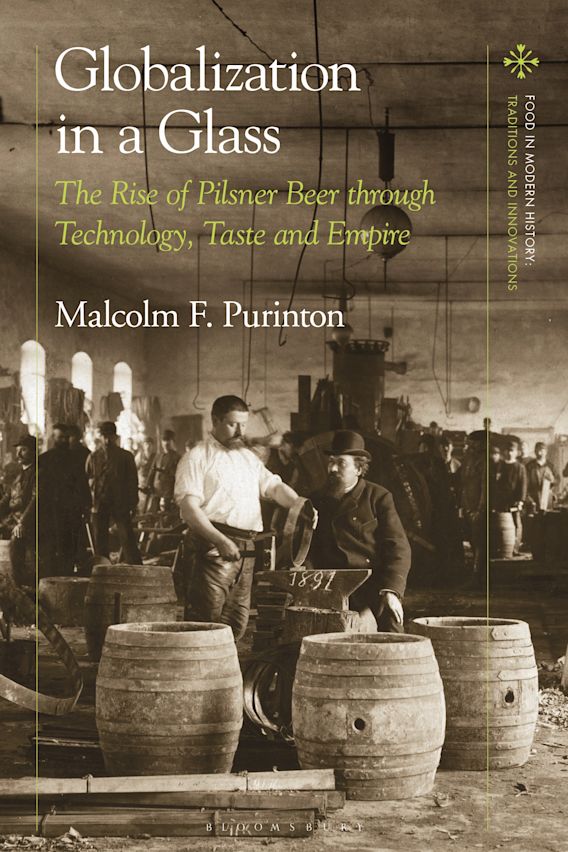Malcolm Purinton, assistant teaching professor of history at Northeastern University, thinks we can learn a lot about the world by looking through a glass of beer.
Purinton’s book, “Globalization in a Glass: The Rise of Pilsner Beer through Technology, Taste and Empire,” examines how the popularization — and global dominance — of a certain style of beer provides a window onto how the world shifted, expanded and industrialized over the 19th century.
Pilsner — a light-in-color lager style of beer — first appeared in Pilsen, in the Bohemia region of the Czech Republic, in 1842. “Within four years you’re starting to see beers called pilsners in Prague,” Purinton says, “which doesn’t make any sense, because it’s not from Prague, and the ‘er on the end of the name means ‘from Pilsen!’”
Purinton’s own fascination with pilsner came as a surprise.

“I was swing dancing at this bar,” he says with a laugh. When he stopped to catch his breath he noticed a stylized poster that read, “Beer: bringing you good times since 1842.”
Purinton — who earned his Ph.D. from Northeastern — says that what he first noticed was the odd specificity of the year. That curiosity eventually led to a dissertation and now “Globalization in a Glass.”
In the late 19th century, Purinton says, “the British Empire was ruling over a quarter of the world’s landmass and 70% of the world’s population. Wouldn’t you expect that everyone would be drinking a British style beer?”
But that, he discovered, was decidedly not the case. “It was all pilsner by the turn of the 20th century,” he says. “So at that same moment where Britain is at its apex of power and influence across the world, no one’s drinking their beer.”
Czech-born pilsner had instead become the dominant form of beer, even in the British colonies.
“That became my biggest conundrum,” he continues. Figuring out “how and why that happened.”
“The quick answer is that it was cheaper and it tasted better, but it takes about 180 pages to explain why,” he says with a laugh.
A key part of the story comes down to migration. After pilsner had spread from Bohemia to the neighboring Bavaria region of Germany, Purinton points to a series of wars — beginning with the revolutions that tore across Western Europe in 1848 — as one of the main drivers. “You have floods of Germans — who are brewing a lot — and want [access to] their beer across the entire globe.”

“German populations [were] settling in Peru and Ecuador and Brazil, all through South America and Central America and the United States.” This led to both beer dynasties like Anheuser-Busch in the U.S. and the proliferation of pilsner-style lagers in places like Mexico.
But immigration couldn’t explain the entire phenomenon. Despite pilsner’s popularity in the period there were increased logistical difficulties that also didn’t square. For one, lagers — including pilsners — require colder brewing temperatures and significantly more storage space than the British-style ales.
“‘Lager’ means ‘to store’ in German, that’s actually where that [word] comes from,” Purinton notes. Ale-style beers can take as little as one week to brew, while a pilsner takes closer to three.
“You need refrigeration for that lagering process,” he continues, “which is very hard to do. It’s a lot easier to keep things warm.”
All this storage and refrigeration requires significant capital investment. Luckily, the 19th century had another innovation up its sleeve — as limited liability companies gained ground, Purinton says, they helped solve the investment issue.
Across Continental Europe, industrialization was taking hold, with brewers “adopting the latest and newest scientific and technological advances.”
One of those advances being a new, in-depth understanding of yeast, with Louis Pasteur’s “Studies on Beer.”
As pilsner became its own global industry, it drove innovation on its own power. When Anheuser-Busch — the company that produces Budweiser — “bought up a refrigerated rail company,” Purinton says that “their goal was to create a beer that would basically be as palatable as possible to as many people as possible.”
The industrialized, increasingly scientific 19th century made possible whole new economies of scale. “That’s one of the things that helps propel golden lagers to proliferate — reaching an economy of scale where you’re able to cut your prices across the board,” Purinton says.
The sheer sizes of these new companies would ensure the consistency of their products in diverse markets. “Consistency is king. Knowing that you can pick it up in Mexico City, New York City, L.A., it’s going to taste the same.”
But that consistency doesn’t come without the railroads, “so you can have the transportation of all those raw materials coming in.”
Business innovations, advances in technologies like refrigeration and continent-spanning rail lines all conspired, across the 19th century and after, to make Pilsner a globally present beverage. While it has now become almost ubiquitous, we can still learn a lot from this golden lager about the forces that shaped the modern world.
“Look at what you’re drinking,” Purinton concludes, and “think about what your choices of beer are saying.”
Noah Lloyd is the assistant editor for research at Northeastern Global News and NGN Research. Email him at n.lloyd@northeastern.edu. Follow him on X/Twitter at @noahghola.
